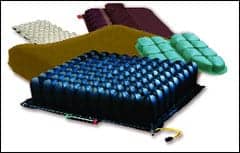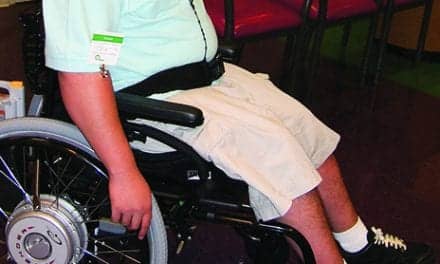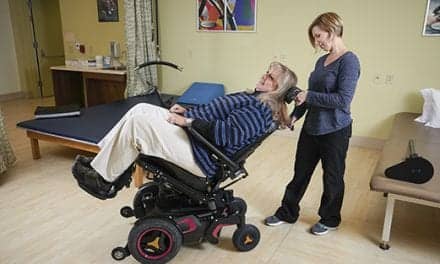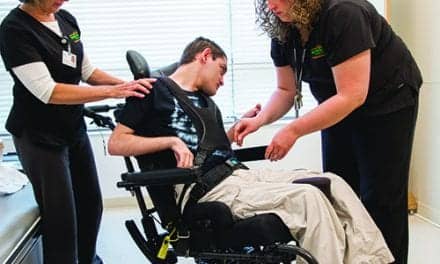 |
Choosing the appropriate support surface is only a matter of asking the right questions and working creatively with all members of the clinical team.
Therapists are integral members of the wound care team—whether formal or informal. As members of the clinical team, therapists must work closely with manufacturers to ensure that the prescribed support surfaces are appropriate for each client.
A support surface is “a specialized device for pressure redistribution designed for management of tissue loads, microclimate, and/or other therapeutic functions (any mattress, integrated bed system, mattress replacement, overlay, seat cushion, or seat cushion overlay).” All surfaces on which clients will be sitting, lying, or transferring should protect them from the risk of skin breakdown.
Before deciding on support surfaces for clients, thoroughly assess and identify the stage and status of existing wounds and/or risk factors for additional wound development. Evaluate equipment with objective data that detail the type of device, its effect on the client’s skin, and any changes in the skin’s appearance and healing. In the overall clinical assessment, factor in the length of time that the device will be used.
Tools and Tactics
Choose support surfaces with a keen eye toward safety in all modes—sitting, lying, or transferring.
Before deciding on support surfaces for clients, identify the stage and status of existing wounds and/or risk factors for additional wound development.
If a powered system is recommended, make sure the client has consistent electricity.
If the surface contributes to harmful sweating or moisture, consider an airflow option.
Establish mobility and safety on the surface during transfers.
Take the client’s space limitations into account.
Determine if the client can afford the additional expense associated with powered systems.
Provide easy access to a vendor for necessary repairs.
Select a surface that can be easily cleaned.
Determine the funding situation and consider all possibilities, including rental.
As with choosing any product, consider the reputation of the manufacturer to ensure ongoing support in case of problems.
The components, features, and categories of support surfaces are numerous. Deciding how to choose and meet each client’s needs is the primary role of the wound care team.
THE RIGHT QUESTIONS
What is the stage or stages of the existing pressure ulcer(s)? You will need to know because proper measuring is crucial to accurately document healing.
If a powered system is recommended, does the client have available and consistent electricity? How much does the surface system weigh? How much does the client weigh? Is pain management part of the plan? Does the surface provide some compression, envelopment, and immersion to assist in wound healing? Does the client experience excessive sweating or moisture that affects the wound?
It is imperative for effective wound healing that the microclimate around the wound is maintained and the client’s body temperature is stable. In these cases, a support surface with airflow can dissipate the heat and moisture and provide an optimal climate and temperature for wound healing. However, take care to ensure that airflow is, in fact, the proper environment for the particular wound.
To facilitate wound healing, it is imperative to maximize blood flow, maintain a favorable healing environment, and minimize risk factors. The extrinsic risk factors that we are most able to address with surfaces are pressure, shear, friction, and moisture. Pain management and client comfort are also essential to optimize prevention and healing.
MOBILITY and safety
Be sure to establish mobility and safety on the surface during transfers. Height of the surface will vary depending on whether a mattress or overlay is used. The amount of immersion and envelopment of the surface will assist in skin protection, body alignment, and the client’s ability to move or be moved within the surface. If an integrated bed system is being used, then adequate space in the client’s environment is necessary to accommodate the system.
ENVIRONMENT/PORTABILITY
If the client will be sleeping in the same bed as their partner, then the support surface must be such that it can be modified to fit the bed. The configuration of the surface may be different than a standard, hospital-style configuration. If the client and partner are on the same bed, then the height of the support surface on one side should be equal to the height of the regular surface that the partner is using on the other side of the bed.
Another consideration is portability. Does the client need to transport the surface or use the support surface on different beds? If this is the case, consider a portable system with ease of setup and maintenance. Once the system is in place, the setup, maintenance, and management of the support surface must be organized with the existing treatment team and caregivers.
SELECTION CONSIDERATIONS
Support-surface terminology has changed. Support surfaces are now considered to redistribute pressures and are either powered or nonpowered.
Once the clinical issues have been identified and goals determined, it is time to determine and prioritize the practical issues of implementing the support surface. These considerations must include space and power requirements, versatility, repairability/durability, infection control/cleaning, cost/reimbursement, and product/company performance.
Space requirements: Is there enough space in the client’s environment to add a hospital bed frame? Must furniture be moved to add a new bed? Who will do this? Can the support surface be placed on the client’s existing bed? Does another room need to be considered?
If the client is in a hospital/long-term care facility, is there space to add the control box to the end of the bed and still allow room for wheelchairs and other equipment for the client, client’s roommate(s), and caregiving staff to pass through the room?
Power requirements: With rising electricity costs, can the client afford the additional expense associated with powered systems? Is there a backup plan in case of power failure?
Versatility: Is the equipment compatible with the client’s lifestyle? If the client is a smoker, is an air-based system the best choice? Can the equipment be maintained? Is setup with the client required, and who will ensure that this routine is maintained (air pressure)?
Durability: Does the client have easy access to a vendor for repairs if they are necessary? Will the product stand up to constant movement of the bed? Is the product being selected for only one client or for multiple clients within a facility?
Infection control and cleaning: Is the surface easily cleaned? Are there facilities in the client’s environment for cleaning? The client/caregiver must be educated as to the proper cleaning methods, regimes, and products to be used. Is the supplier involved in changing covers on a regular basis, and has the delivery routine been established?
Cost and reimbursement: Once the evaluation process is completed and a product selected to meet the client’s clinical needs, does the product meet the client’s means? Has funding been determined? What is the plan while the client waits for funding? Is the product a long-term or short-term consideration, and will there be a plan for “stepping down” the equipment? How will a change affect funding? Should rental be considered?
Product and company performance: As with choosing any product, consider the history of the manufacturer to ensure ongoing support in case of problems with setup, comfort, and product performance.
With so many questions—both clinical and practical—and so many product choices, it is important that therapists assist clients in trying out surfaces with the appropriate clinical features. We must demand good service and support from manufacturers and set standards and routines for product setup, use, and maintenance by clients and caregivers.
 |
Brenlee Mogul-Rotman, OT, ATP, is a therapist at Toward Independence, Richmond Hill, Ontario, Canada.
 |
Kathryn Fisher, OT, ATS, is a home health care education manager at Shopper’s Home Health Care, Toronto. She can be reached via e-mail: .





